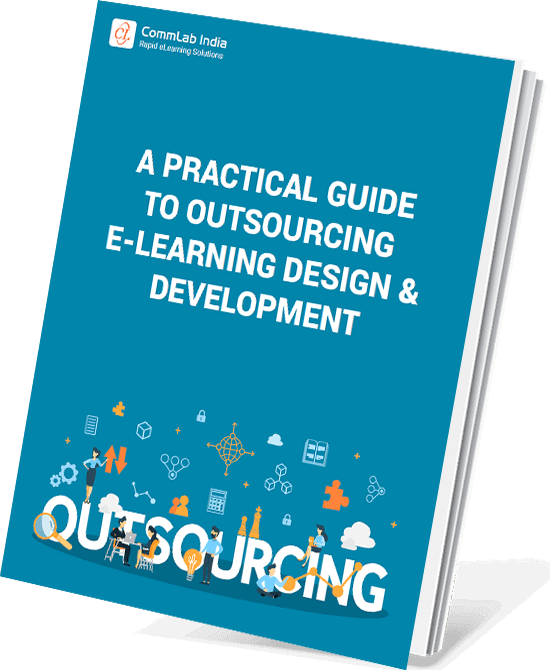Why Custom eLearning is a Game-Changer for Corporate Training

When it comes to corporate training, the age-old question still lingers: Should we go for off-the-shelf courses or invest in custom eLearning solutions? It’s like choosing between a one-size-fits-all outfit and a tailored suit. Both have their place, but when it comes to addressing unique needs, custom eLearning often takes the lead.
→ Download eBook: Selecting the Right Vendor for eLearning Development Outsourcing
Take compliance training, for example. Let’s say your organization operates in a niche industry with highly specific regulations. Off-the-shelf courses might provide a generic overview of compliance topics but fail to address your organization's unique policies, procedures, and risk areas.
Now imagine a custom eLearning course. It can be designed to reflect your company’s real-world scenarios, using role-specific examples and branded content to engage learners effectively. You could even include interactive case studies or simulations based on your company’s past compliance challenges. This not only makes the training more relatable but also significantly boosts retention and application of critical knowledge—something a generic course can’t achieve.
So, while off-the-shelf solutions may save time initially, custom eLearning delivers a far greater impact when you need training tailored to your business.
Table Of Content
- What Is Custom eLearning?
- What are the Benefits of Custom eLearning to Organizations?
- What are the Factors to Consider Before Investing in Custom eLearning?
- How to Choose a Vendor for your Custom eLearning Development Requirement?
What Is Custom eLearning?
Custom eLearning refers to eLearning courses that are specifically designed to meet the unique learning needs of employees and organizational business goals.
As the saying goes, “If you try to be everything to everyone, you end up being nothing to anyone.” While generic courses offer an easy solution for corporate training, they can lack relevance, leading to disengaged learners and lower retention rates.
In contrast, custom eLearning solutions follow a targeted approach where training content is precisely tailored to meet the learning requirements of the employees and enhance productivity and efficiency. All these aspects combine to ensure an effective corporate training program and achieve an overall positive training ROI.
What are the Benefits of Custom eLearning to Organizations?
Benefits of Custom eLearning for Organizations:
- Personalized training pathways for employees.
- Alignment of learning objectives with organizational goals.
- Flexible budget options.
- Optimized, relevant content for better engagement.
1. Provides a Personalized Training Pathway
Custom eLearning solutions allow organizations to create training programs that cater specifically to the unique needs of their employees, departments, or teams. Unlike generic, one-size-fits-all training, bespoke eLearning ensures that the learning paths are tailored to the skills and roles required by each group. For example, the sales department might benefit from eLearning modules focused on negotiation techniques and CRM tools, while the IT department might require training on cybersecurity protocols and emerging technologies.
Moreover, custom eLearning can address individual learning preferences by incorporating diverse learning formats. For organizations with a global workforce, training can also be customized to reflect cultural nuances, ensuring that the content resonates with employees from various backgrounds. For instance, a multinational corporation can create region-specific compliance training modules that adhere to local regulations and laws, while still aligning with the company’s global standards.

2. Aligns Learning Objectives with the Organization’s Goals
To truly drive business growth, learning objectives must align with an organization’s overall goals and mission. Custom eLearning allows businesses to design programs that reflect their brand identity and strategic priorities. For example, an organization aiming to improve customer satisfaction can create a customer service training program with scenario-based learning on the company’s service philosophy and customer interaction history.
This alignment ensures that every employee understands how their role contributes to the larger business objectives. Off-the-shelf programs often miss this mark, as they are designed for generic use and fail to address the unique challenges and opportunities faced by specific organizations. A custom eLearning platform can include role-specific goals and KPIs, such as increasing client retention rates, that motivate employees to perform better and directly contribute to the company’s success.
3. Improves Learning Effectiveness
Custom eLearning enhances learning effectiveness by making the training highly relevant and practical. Scenarios, simulations, and examples used in the course can be directly inspired by real-life situations within the organization. For instance, a training module for a logistics company could include an interactive scenario where employees must solve issues related to supply chain delays or optimize delivery routes. Such relevant examples help employees quickly connect the training to their daily work, making it easier to apply skills on the job.
This relevance not only improves engagement but also boosts knowledge retention. Employees are more motivated to complete training when they see its immediate value in solving their workplace challenges. For example, a customer service representative who completes a training simulation on handling irate customers will be better prepared to handle similar real-life scenarios. This leads to increased productivity and a higher return on investment (ROI) for training initiatives.
Experience Custom eLearning Training Solutions that Align with your Business Goals
4. Optimizes Content
Off-the-shelf courses often include generic content that may not be directly relevant to an organization’s needs, leading to wasted time and effort. Custom eLearning, on the other hand, streamlines training by delivering content that is directly applicable to the intended learners with relevant eLearning interactivities.

For instance, if an organization specializes in software development, a custom eLearning program can focus on specific coding languages, project management tools, and compliance standards relevant to the tech industry. Additionally, bespoke eLearning makes it easy to update or modify content as needed. For example, if a new regulation is introduced, such as GDPR updates for data privacy, the eLearning course can quickly be revised to include the latest information. This ensures that employees are always equipped with accurate and up-to-date knowledge, which enhances the overall training quality and keeps the workforce competitive.
5. Offers Flexible Budget
One common misconception about custom eLearning development is that it is always expensive. In reality, custom eLearning solutions can be designed to fit within an organization’s budget while still meeting training needs. A good eLearning company works closely with the business to identify priorities and find cost-effective solutions. For instance, instead of creating a full-scale custom training program, an organization might choose to customize only critical sections of an off-the-shelf course to include company-specific content, like branding, case studies, or workflows.
For example, a startup with a limited budget might work with an eLearning company to create custom onboarding training that introduce new hires to the company’s values, policies, and tools, while using generic off-the-shelf content for broader topics like workplace ethics. This approach allows businesses to deliver high-quality training without overspending, ensuring maximum value for every dollar spent.

6. Ensures Brand Consistency
Every organization has its own brand identity, vision, values, and culture. But when you opt for catalog courses, it’s once in a blue moon that you find the perfect course that contains the desired training content and also aligns with your company values and vision. Mostly, with off-the-shelf courses, it’s like shooting in the dark.
Whereas custom eLearning allows you to infuse unique, specific elements of your brand identity and culture into the training programs. And if you’re thinking why all this fuss, does it even matter? Let me tell you… it does. In fact, it matters a lot.
By using consistent branding, messaging, and tone of voice, you can ensure that all employees, regardless of location, receive the same brand-aligned experience. This consistency helps build a unified organizational culture and ensures that employees understand and embody the company's values and mission.

A Practical Guide to Outsourcing E-Learning Design & Development
Tips and Best Practices for an Effective Outsourcing Journey
- eLearning Elements that can be Outsourced
- Tasks Before Outsourcing
- Tips for Selecting the Right eLearning Vendor
- Ways to Support your Vendor
What are the Factors to Consider Before Investing in Custom eLearning?
Well, the points mentioned in the previous section definitely build a strong case for investing in custom eLearning. Right? But before you jump head first, there are several factors that must be considered to ensure the investment aligns well with your training goals and resources.
Organizational Goals and Objectives
Having a clear idea about the learning objectives and key goals of the corporate training is the basic step to begin with. Once you’re sorted with this part, then try to understand how bespoke eLearning can support these goals and objectives. Understanding the strategic direction of the organization plays an integral role in determining whether custom eLearning is the right fit or not.
For instance, if the goal is to drive innovation and leadership within the company, investing in custom eLearning programs that focus on leadership development and creative problem-solving might be the answer.
Target Learner Group and their Learning Preferences
Employees are the backbone of an effective, successful business. Therefore, paying attention to their learning needs and preferences must be the center of attention when you’re considering investing in custom eLearning for corporate training. So, try to gather information that offers insights on skill gaps, common learning styles, etc. Knowing your target learner group will help you in designing and developing effective custom eLearning courses.

For example, younger employees in the company might prefer mobile learning with gamified elements, while employees with a higher level of experience might value detailed case studies and simulations. So by tailoring the learning experience to the learner's preferences, you can enhance learner engagement and the overall effectiveness of your training program.
Training Budget

Custom eLearning is an investment, and like any investment, it requires careful budgeting. You must plan the amount of money you’re willing to spend in order to go ahead with custom eLearning in contrast to the sum required to ensure high-quality, engaging, and effective bespoke eLearning solutions. To evaluate the total costs involved in custom eLearning, consider design, development, implementation, and maintenance.
Training ROI Expectations
If your budget indicates a green signal for custom eLearning, congratulations! Now it’s time to put in some extra thought and gather clarity on how will you define the success of your eLearning training program. Like, will success be measured by improved employee performance, increased sales, enhanced customer satisfaction, or any other factor? Setting clear outcomes for training ROI enables you to measure the effectiveness of the approach in quantitative terms.
Potential Challenges and Risks
Life is not without its challenges and risks and neither is custom eLearning. However, taking into account the potential challenges and risks and brainstorming the possible solutions or ways to mitigate the challenges is how you should proceed. Not every solution might turn out as per your expectation but you’ll be more prepared and have the confidence to be face-to-face with challenges and not give up if things get difficult.
A few common challenges can be scope creep, content becoming outdated, not finding the right eLearning outsourcing vendor, etc. To give you an idea, scope creep is where the project expands beyond the original plan, resulting in increased costs and timelines. Well, taking these challenges into consideration, you must have a clear plan and strategy in place to mitigate these risks and ensure that the bespoke eLearning solution remains relevant and effective over time.
Existing eLearning Infrastructure and Resources
You might not really like it but considering this factor is the key to making an informed decision. That’s right! When you plan on investing in custom eLearning solutions, always answer this question first, “Does my organization have the necessary infrastructure?”
The necessary infrastructure here includes digital technology platforms, eLearning authoring tools, learning management systems (LMS), and technical support. Apart from these elements, also consider the availability of in-house expertise that is required to bring your custom eLearning courses to life. This includes instructional designers, eLearning developers, and subject matter experts (SMEs). If the answer is no, don’t lose hope. You can always enjoy the benefits of custom eLearning by considering the option of eLearning outsourcing!

A Practical Guide to Outsourcing E-Learning Design & Development
Tips and Best Practices for an Effective Outsourcing Journey
- eLearning Elements that can be Outsourced
- Tasks Before Outsourcing
- Tips for Selecting the Right eLearning Vendor
- Ways to Support your Vendor
How to Choose a Vendor for your Custom eLearning Development Requirement?
How does one go about choosing a vendor to create specific content for your organization? It’s good to use a Request for Proposal (RFP) where vendors can convince you of their expertise.
First, you will need eLearning outsourcing vendors who are articulate and can provide the documentation which they expect to use for your project.
Look for Articulate Vendors with Clear Documentation
Are your writers and instructional designers experienced to take on your standard and volume of work? Are they eager to do it? Do they have professional degrees that prove their calibre? Have you checked out their resumes?
Does the vendor have enough past work to show his competence?
Your courses must be targeted to teaching a particular subject. Can your vendor furnish any case studies that were successfully implemented? Check out different kinds of parameters that show the vendor’s worth.
Review Their Portfolio of Similar Projects
Ask your eLearning outsourcing partner to show you courses or demos that resemble what you’re looking for. If he has something like that, he will show it to you happily or may create one using your content.
Assess Their Use of the Latest Authoring and AI Tools
Ensure the eLearning outsourcing vendor is proficient with the latest eLearning authoring tools and AI tools for eLearning design and development. Advanced tools can streamline development, enhance interactivity, and provide adaptive learning experiences. eLearning companies leveraging AI tools can also offer analytics-driven insights and automated solutions to improve content quality and learner engagement.
Ensure Transparency in Project Information
Often, eLearning vendors are blamed for not disclosing project information particularly about the development cycle. If your vendor is open about problems he encounters and shares them with you, it can work in his favour at selection time.
Watch this video to unlock tips to make the most of your eLearning outsourcing partnership!
Evaluate their Ability to Simplify Complex Concepts
There are courses that deal in difficult concepts, but if a vendor can get a handle on these concepts and explain it in simple terms, he has a clear edge over his competitors.
Request a Prototype During Development
Most often, elearning companies make the mistake of waiting to complete the whole course before showing it to the client. It’s best, however, to use a vendor who has in-built prototyping steps in the instructional development process. He should create a prototype of all the newness in the course as it develops and show it to the client.
Ask for a Detailed Quote Before Starting the Project
You may be worried about being overcharged for outsourcing custom eLearning design and development. So, to cut out the element of surprise, ask for a quotation. Usually, as the level of sophistication increases and you ask for media-rich content like video, audio, and animations, the cost will escalate proportionately. You must sample all bids for your project.
Ready to get the most out of your eLearning investment? Here are some smart tips to stretch your budget while outsourcing.
Wrapping Up!
And there you have it—custom eLearning is a game-changer for organizations looking to elevate their training programs. From boosting employee engagement to tailoring content for specific needs, the benefits are undeniable. But creating effective custom eLearning requires the right expertise.
Want to learn how to get the most out of eLearning outsourcing? Download our free eBook packed with tips and tricks to help you navigate the process and create impactful learning experiences for your team. Start transforming the way your employees learn and grow today!



![How to Choose An eLearning Vendor that’s Just Right for You! [Video]](https://blog.commlabindia.com/hubfs/Imported_Blog_Media/elearning-vendor-selection-guide-video-v2.jpg)

![Objections to Outsourcing eLearning Decoded [Video]](https://blog.commlabindia.com/hubfs/Imported_Blog_Media/elearning-outsourcing-objections-solutions-video.jpg)